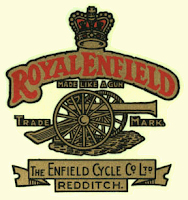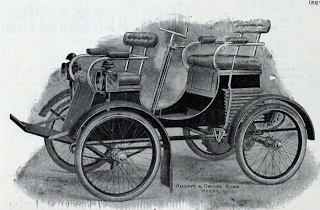In 1891 , Albert Eadie (1850 - 1931) and Robert Walker Smith (1857 - 1933) bought out George Townsend and Co which was in the business of manufacturing sewing needles, fishing hooks and bicycles. They renamed the company as Eadie Manufacturing Company.
Apart from the existing business , Eadie Manufacturing was also supplying weapon and rifle parts to Royal Small Arms factory located at Enfield. On receiving a large supply contract from them , Eadie Manufacturing named their bicycle as Enfield, in celebration. In 1892 , they added the "Royal" and thus became Royal Enfield bicycles.
In 1893, the line "Made like a Gun" was added in the company logo. In 1896, a new company - New Enfield Cycle Company was created to concentrate on the bicycle business. In 1897 , the company was renamed as Enfield Cycle Company Ltd.
Enfield was known for designing varieties of bicycle variants and were one of the pioneers in the evolution of bicycles - ladies bicycle, back pedal brakes, sprockets etc.
Some of the early bicycles - a 1895 Eadie Boneshaker and a 1904 Enfield Tandem bicycle.
Enfield Cycle Company started experimenting with motorised cycles and in 1898 brought the first motorised Quadracycle with De-Dion engine.
Due to booming business on bicycles, Enfield did not concentrate on motorisation and it was not until 1903 they introduced motorcycles. A 1913 and a 1923 Royal Enfield Motorcycle -
In 1906, Enfield Cycle Company created a separate company to manufacture cars, named as Enfield Autocar Company. In 1907 , Enfield Autocar Company was acquired by Alldays and Onions. From 1919 cars were made under the Enfield-Alldays brand.
Enfield Cycle Company continued to make motorcycles under the Royal Enfield brand and were major suppliers to Military and Army across the world and were major contributors during both the world wars.
In 1932, the legendary "Bullet" was introduced with various engine options.
In 1949, the Indian Army imported the Royal Enfield Bullet as the motorcycle for their use in border patrol and in 1955 Bullet was manufactured in India in collaboration with Madras Motors in Madras (now Chennai). Later on the name was changed to Enfield India as the motorcycle was fully localised.
In 1968, owing to financial troubles, the Enfield Cycle Company was sold to Norton-Villiers-Triumph and the brand disappeared from 1970.
However, the Royal Enfield continued to be manufactured in India as Enfield India. In 1994, Enfield India was acquired by Eicher group. Eicher group repurchased the Royal Enfield brand in 1995 and now is being used in all the Enfield Motorcycles being manufactured in India.
The Logo of Enfield Cycle Company and Royal Enfield -



































